 Understanding Earnings
Understanding EarningsThis chapter provides an overview of earnings and discusses how to:
Modify delivered earnings elements.
Create new earnings.
 Understanding Earnings
Understanding EarningsThis section discusses:
Delivered earnings.
Delivered supporting elements.
Process lists and sections.
How to view delivered elements.

 Delivered Earnings
Delivered Earnings
PeopleSoft Global Payroll for China delivers a number of earnings that demonstrate the flexibility of PeopleSoft Global Payroll rules to meet common processing requirements such as the calculation of wages and overtime.
In this table, the first column combines the name and description of the delivered earnings. The other columns indicate the calculation rule components, such as unit, rate, percent, and amount, and the generation control for each earning. NA represents calculation rule components that are not applicable.
|
Name/Descr. |
Unit |
Rate |
Percent |
Amount |
Generation Control |
Pre-Process and Post-Process Formula |
|
MONTH SALARY Monthly Salary |
NA |
NA |
NA |
CN RC BASE SALARY (Rate Code - Amount) |
CN GC ACTIVE |
Post - CN FM REDUCE SALRY |
|
13THMNTH PAY 13th Month Pay |
NA |
NA |
NA |
CN FM RSLV 13MTH (Formula - Monetary & Decimal) |
CN GC 13TH MTH |
NA |
|
VAR BONUS Variable Bonus |
NA |
NA |
NA |
Payee Level |
NA |
NA |
|
SPOUSE ALLOW Spouse Allowance |
NA |
NA |
NA |
CN BR SPOUSE ALW (Bracket - Numeric) |
CN GC SPOUSE CHK |
NA |
|
HOUSE ALLOW House Allowance |
NA |
NA |
NA |
CN BR HOUSE ALW (Bracket - Numeric) |
CN GC ACTIVE |
NA |
|
COMMISSION Commission Payments |
NA |
NA |
NA |
Payee Level |
CN GC ACTIVE |
NA |
|
TERM PAY Termination Pay |
NA |
NA |
NA |
CN FM TERM PAY (Formula - Monetary & Decimal) |
NA |
NA |
|
OVERTIME PAY Weekday Overtime Pay |
Payee Level |
HOURLY RT (System Element - Numeric) |
150% |
NA |
NA |
NA |
|
OVERTIME 2.0 Weekend Overtime Pay |
Payee Level |
HOURLY RT (System Element - Numeric) |
200% |
NA |
NA |
NA |
|
OVERTIME 3.0 Public Holiday Overtime Pay |
Payee Level |
HOURLY RT (System Element - Numeric) |
300% |
NA |
NA |
NA |
|
SEVERANCE Severance Pay |
NA |
NA |
NA |
CN FM SEV AVG PAY (Formula - Monetary & Decimal) |
NA |
NA |
|
RTO 13BASE Retro for 13mth base sal accum |
NA |
NA |
NA |
Payee Level |
CN GC ACTIVE |
NA |
|
RTO TOT DAYS Retro 13mth pay - tot wrk days |
NA |
NA |
NA |
Payee Level |
CN GC ACTIVE |
NA |
|
RTO WRK DAYS Retro prd - no of work days |
NA |
NA |
NA |
Payee Level |
CN GC ACTIVE |
NA |
|
RTO EARNINGS Retro Earnings |
NA |
NA |
NA |
Payee Level |
NA |
NA |
|
RTO VAC PD Retro Vacation Paid |
Payee Level |
Payee Level |
NA |
NA |
NA |
NA |
|
RTO VAC UNP Retro Vacation Unpaid |
Payee Level |
Payee Level |
NA |
NA |
NA |
NA |
Note. These elements are defined as PS Delivered/Not Maintained. This means that you can use them as delivered, modify them, or replace them with new elements.
Note. Global Payroll for China also delivers absence-related earnings. These are discussed in a separate chapter in this PeopleBook.
See Setting Up Absence Elements.
Global Payroll for China delivers the MONTH SALARY earning as an example of how to calculate monthly salary for your payees.
The CN GC ACTIVE generation control ensures that only payees with a Job status of Active receive the MONTH SALARY earning.
The system determines the amount of MONTH SALARY based on the CN RC BASE SALARY rate code.
The post processing formula CN FM REDUCE SALRY reduces MONTH SALARY by any leave taken during the period.
The proration rule GP PRORATE WRK DAY prorates MONTH SALARY based on the number of days worked in the calendar period.
Note. Proration and rounding rules are set at the pay group level.
This diagram illustrates the process flow for the MONTH SALARY earning:
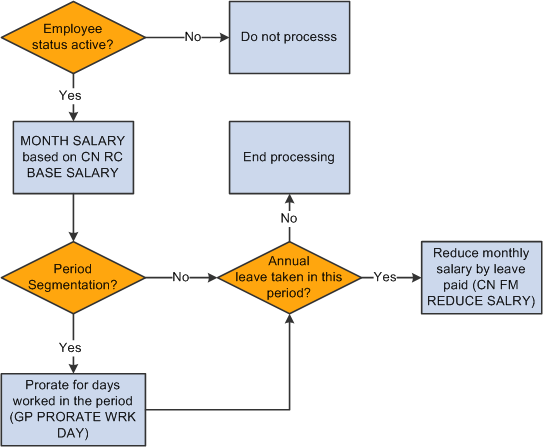
Process flow for MONTH SALARY earning
Global Payroll for China delivers the OVERTIME PAY earning as an example of how to calculate overtime pay for your payees.
The system calculates OVERTIME PAY using positive input units * HOURLY RT * 150%.
No proration is required because the assumption is that OVERTIME PAY will be entered through positive input.
This diagram illustrates the process flow for the OVERTIME PAY earning:

Process flow for OVERTIME PAY earning
Global Payroll for China delivers the VAR BONUS earning as an example of how to enter variable bonus pay for your payees.
VAR BONUS is a fixed amount earning entered through positive input.
No proration is associated with VAR BONUS.
This diagram illustrates the process flow for the VAR BONUS earning:
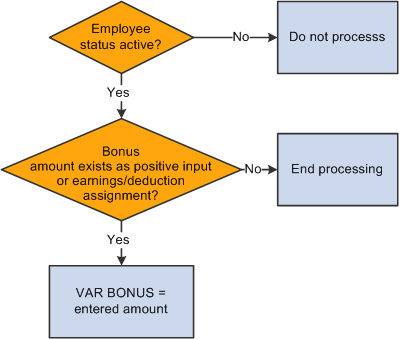
Process flow for VAR BONUS earning
Global Payroll for China delivers the 13THMNTH PAY earning as an example of how to provide 13th Month Pay for your payees.
The system pays 13THMNTH PAY annually based on the previous 12 months' earnings.
The system calculates 13THMNTH PAY using a payee's base monthly salary only (annual salary/12, prorated for days worked during the month), not the actual MONTH SALARY earning. It also does not include any allowances or deductions in the calculation of 13THMNTH PAY.
For payees hired between the 1st and 15th of a month in the calculation year, 100% of their base monthly salary for the hire month and subsequent months contributes to 13THMNTH PAY. For payees hired after the 15th of a month, 50% of the base monthly salary for the hire month and 100% of the base monthly salary for subsequent months contribute to 13THMNTH PAY.
The system prorates 13THMNTH PAY for unpaid vacation leave taken during the year, that is, leave days exceeding the annual leave entitlement.
This diagram illustrates the process flow for the 13THMNTH PAY earning:
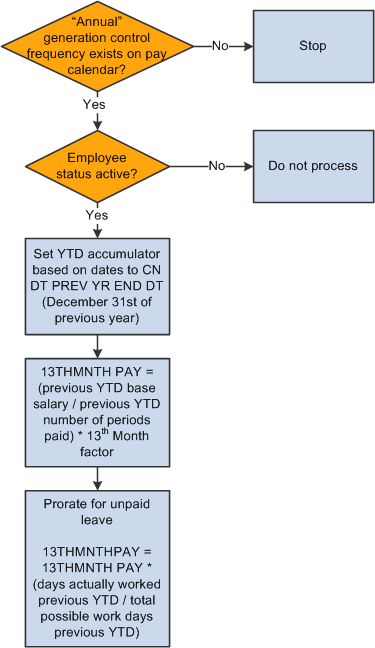
Process flow for 13THMNTH PAY earning
Global Payroll for China delivers the HOUSE ALLOW earning as an example of how to calculate a house allowance for your payees.
The system calculates the HOUSE ALLOW earning based on the CN BR HOUSE ALW bracket, which associates house allowances with annual rates of pay.
The system prorates HOUSE ALLOW for calendar periods using GP PRORATE WRK DAY.
Note. Proration and rounding rules are set at the pay group level.
This diagram illustrates the process flow for the HOUSE ALLOW earning:
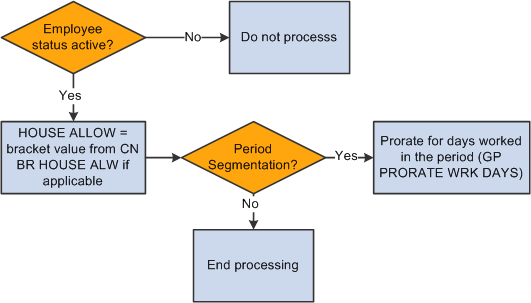
Process flow for HOUSE ALLOW earning
Global Payroll for China delivers the SPOUSE ALLOW earning as an example of how to calculate a spouse allowance for your payees.
The generation control CN GC SPOUSE CHK determines whether payees are eligible for the SPOUSE ALLOW earning based on their marital status and employee type. Only married expatriate payees receive the SPOUSE ALLOW earning.
The system calculates the SPOUSE ALLOW earning based on the CN BR SPOUSE ALW bracket, which associates spouse allowances with employee type and annual rate of pay.
The system prorates SPOUSE ALLOW for calendar periods using GP PRORATE WRK DAY.
Note. Proration and rounding rules are set at the pay group level.
This diagram illustrates the process flow for the SPOUSE ALLOW earning:
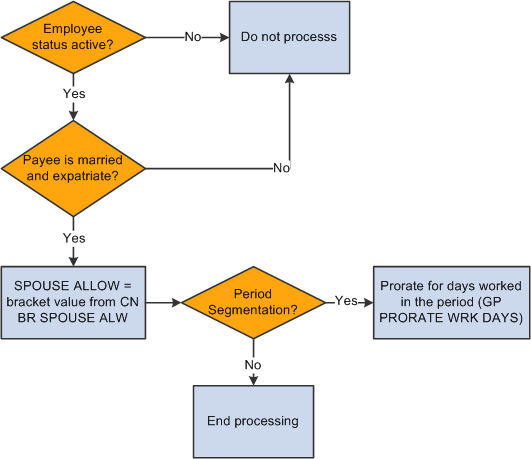
Process flow for SPOUSE ALLOW earning
Global Payroll for China delivers the COMMISSION earning as an example of how to enter commission pay for your payees.
COMMISSION is a fixed amount earning entered through positive input.
No proration is associated with COMMISSION.
This diagram illustrates the process flow for the COMMISSION earning:
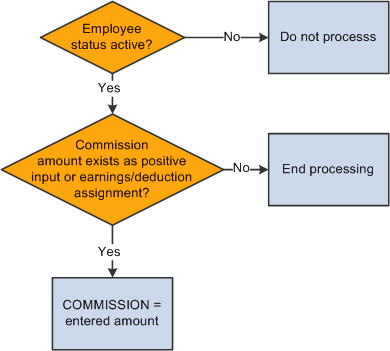
Process flow for COMMISSION earning
Global Payroll for China delivers six retro earnings:
RTO 13BASE
RTO TOT DAYS
RTO WRK DAYS
RTO EARNINGS
RTO VAC PD
RTO VAC UNP
The system uses these earnings to forward actual earnings information from a retro period to the current period when it encounters retro during a payroll run.

 Delivered Supporting Elements
Delivered Supporting Elements
This table lists the key supporting elements used to define the delivered earnings:
|
Element Type |
Element Name |
Used By |
Function |
|
Variable |
CN VR EE TYPE |
SPOUSE ALLOW |
Indicates the employee type: LOC (local), DIS (disabled), or EXP (expatriate). LOC is the default value, but can be modified based on Citizenship status or Disability status, or through the use of a supporting element override. |
|
CN VR 13MTH FCTR |
13THMNTH PAY |
The number of months' pay to be paid as a 13th Month Pay bonus. The default is 1, but you can override it at the pay entity, pay group, or payee level. |
|
|
CN VR GOVT WRK DAYS |
13THMNTH PAY |
The government-regulated number of work days per month. The system uses this in 13th Month Pay calculations when determining the applicable proration factor for unpaid leave days in the previous year. The default value is 20.92, but you can override it at the pay group or payee level. |
|
|
Formula |
CN FM REDUCE SALRY |
MONTH SALARY |
Reduces monthly salary earnings by any paid or unpaid earnings for a calendar period. |
|
CN FM RSLV 13MTH |
13THMNTH PAY |
Calculates 13th Month Pay for the previous YTD. |
|
|
CN FM ACUM PCT |
13THMNTH PAY |
Determines the percentage (50 or 100) of the base monthly salary that should contribute to the 13th Month Base segment accumulator, including any proration of the amount due to segmentation. |
|
|
Bracket |
CN BR HOUSE ALW |
HOUSE ALLOW |
Stores the earnings amount lower limit and the house allowance amount for that limit. If a payee's annual earnings amount is between two amounts in the bracket, the system selects the lower amount. |
|
CN BR SPOUSE ALW |
SPOUSE ALLOW |
Stores the employee type, earnings amount lower limit, and spouse allowance amount or that limit. If a payee's annual earnings amount is between two amounts in the bracket, the system selects the lower amount. |
|
|
Generation Control |
CN GC ACTIVE |
MONTH SALARY HOUSE ALLOW COMMISSION RTO 13BASE RTO TOT DAYS RTO WRK DAYS |
Determines whether the payee has a Job status of active at the time of processing. |
|
CN GC SPOUSE CHK |
SPOUSE ALLOW |
Determines payee eligibility for the SPOUSE ALLOW earning based on marital status and employee type (CN VR EE TYPE). For a payee to be eligible for the SPOUSE ALLOW earning, marital status must equal Married and employee type must equal EXP (expatriate). Also determines whether the payee has a Job status of active at the time of processing. |
|
|
CN GC 13TH MTH |
13THMNTH PAY |
Initiates 13th Month pay processing by checking for a generation control frequency of ANNUAL on the pay calendar associated with the pay run. Also determines whether the payee has a Job status of active at the time of processing. |

 Process Lists and Sections
Process Lists and SectionsTERM PAY and SEVERANCE are members of the CN SE TERMINATION section. The rest of the delivered earnings are members of the CN SE EARNINGS section.
The CN SE EARNINGS and CN SE TERMINATION sections are included in the CN PR PAYROLL process list.

 Viewing Delivered Elements
Viewing Delivered ElementsThe PeopleSoft system delivers a query that you can run to view the names of all delivered elements designed for China.
See PeopleSoft Global Payroll PeopleBook, "Viewing Delivered Elements," Understanding How to View Delivered Elements.
 Modifying Delivered Earnings Elements
Modifying Delivered Earnings Elements
Global Payroll for China delivers earnings-related elements based on practices that are common to many businesses in China. Although most of the delivered elements are created according to common industry standards or based on statutory requirements, a company's specific business practices may require modifications to them. This section provides examples of common modifications to earnings elements.

 Modifying 13THMNTH PAY Earnings
Modifying 13THMNTH PAY EarningsCurrently the system uses base monthly salary as the basis for calculating the 13THMNTH PAY earning. To use net pay as the basis instead of base monthly salary, modify the members of the segment accumulator CN AC 13BASE SEG by removing the rate code CN RC BASE SALARY and replacing it with CHN NET.

 Modifying TAXABLE SP PAYMENT
Modifying TAXABLE SP PAYMENT13THMNTH PAY is the delivered contributing earning for the TAXABLE SP PAYMENT accumulator. You can replace 13THMNTH PAY with a different contributing earning that you want to be taxed as an annual bonus.
Note. If you use the delivered 13THMNTH PAY earning for
13th month pay, and if you leave this earning in the TAXABLE SP PAYMENT accumulator,
then 13th month pay is taxed as an annual bonus.
If 13th month pay is to be taxed as salary rather than as an annual
bonus, you must modify the delivered setup so that you have a 13th month pay
earning that is part of the TAXABLE NORMAL SAL accumulator and not part of
the TAXABLE SP PAYMENT accumulator. Specifically, if you continue
to use the delivered 13THMNTH PAY earning for 13th month pay, you must modify the
accumulator definitions. Alternatively, you can use a different earning;
the delivered VAR BONUS earning is suitable for this purpose, or you can create
a new earning.
 Creating New Earnings
Creating New Earnings
This section discusses:
The accumulator structure of earnings.
How to configure earnings/deduction assignments and override components.

 Understanding the Accumulator Structure of Earnings
Understanding the Accumulator Structure of EarningsIf you create new earnings, make sure that they conform to the accumulator structure of the delivered earnings. This is to ensure that the new elements are processed correctly and are included in the appropriate gross-to-net calculations.
See PeopleSoft Global Payroll PeopleBook, "Defining Earning and Deduction Elements".
Accumulator Structure of Earnings
This table describes the accumulator structure of earnings:
|
Accumulator Name |
Description |
Contributing Earnings |
|
CHN GROSS |
Gross pay for China |
VACATION PD (not China-specific) MONTH SALARY 13THMNTH PAY VAR BONUS SPOUSE ALLOW HOUSE ALLOW COMMISSION TERM PAY OVERTIME PAY SEVERANCE RTO EARNINGS RTO VAC PD |
|
TAXABLE NORMAL SAL |
Total taxable normal salary |
VACATION PD (not China-specific) MONTH SALARY VAR BONUS SPOUSE ALLOW HOUSE ALLOW COMMISSION TERM PAY OVERTIME PAY |
|
TAXABLE SP PAYMENT |
Taxable special payment |
13THMNTH PAY |
|
TAXABLE SEVERANCE |
Taxable severance pay |
SEVERANCE |
|
CN AC ROLLAVG SAL |
Rolling average monthly salary for severance |
VACATION PD (not China-specific) MONTH SALARY 13THMNTH PAY VAR BONUS SPOUSE ALLOW HOUSE ALLOW COMMISSION OVERTIME PAY RTO EARNINGS RTO VAC PD |
|
CN AC 13BASE YTD |
13th Month salary base YTD |
RTO 13BASE |
|
CN AC TOT DAYS YTD |
13th Month total work days YTD |
RTO TOT DAYS |
|
CN AC DAYS WKD YTD |
13th Month days worked YTD |
RTO WRK DAYS |

 Understanding How to Configure Earnings/Deduction Assignments and Override
Components
Understanding How to Configure Earnings/Deduction Assignments and Override
Components
If you create earnings that use variables or other supporting elements in their calculations, you can modify or replace the standard supporting element override components to facilitate entering the values of these variables and other elements at either the payee or calender ID override levels.
Note. You can modify the standard supporting element override components by adding or changing field labels, prompt tables, and other page elements to better suit the elements that you want to override.
See Also
PeopleSoft Global Payroll PeopleBook, "Configuring Element Overrides"